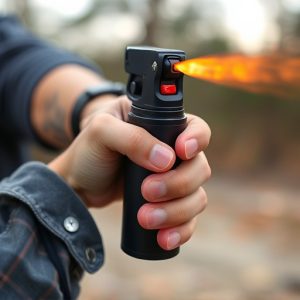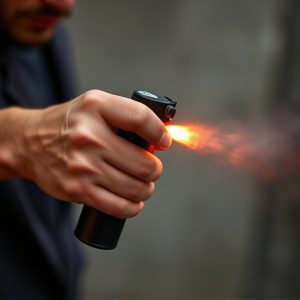Pepper Spray Crowd Control: Safety, Care, and Prevention Strategies
Pepper spray, a standard crowd control tool, temporarily disables individuals through irritation. Pr…….
Pepper spray, a standard crowd control tool, temporarily disables individuals through irritation. Proper Immediate Care for Pepper Spray is crucial after exposure. This includes moving to fresh air, removing contaminated clothing, washing affected areas with water for 15 minutes, and seeking medical attention for severe reactions. Law enforcement agencies, trained in pepper spray application and de-escalation techniques, play a vital role in public safety during high-pressure situations. Crowd control strategies should focus on de-escalation and non-lethal force options to minimize the need for chemical agents, with immediate care and decontamination procedures significantly reducing their impact.
In today’s dynamic law enforcement landscape, understanding crowd control tactics like pepper spray is paramount. This potent tool can quickly de-escalate situations, but proper application and immediate care after exposure are crucial. Our comprehensive guide delves into the mechanics of pepper spray, offers essential tips for immediate care following exposure, explores the role of law enforcement in safe deployment, and provides prevention strategies to mitigate incidents. By understanding these key aspects, we enhance community safety and well-being.
- Understanding Pepper Spray: A Tool for Crowd Control
- Immediate Care After Exposure to Pepper Spray
- The Role of Law Enforcement in Safe Application
- Prevention and Mitigation Strategies for Pepper Spray Incidents
Understanding Pepper Spray: A Tool for Crowd Control
Pepper spray, also known as oleoresin capsicum (OC) spray, is a powerful crowd control tool used by law enforcement agencies worldwide. It’s a non-lethal chemical agent designed to temporarily incapacitate individuals and create distance between officers and potential threats. When deployed, pepper spray irritates the eyes, nose, and throat, leading to coughing, difficulty breathing, and temporary blindness. This immediate effect allows police to control and disperse crowds quickly and efficiently, ensuring public safety and maintaining order.
While effective in crowd control, proper immediate care after exposure to pepper spray is essential. Those affected should move to a safe area with fresh air immediately. Removing contaminated clothing and washing eyes, face, and any open wounds with plenty of water for at least 15 minutes can help alleviate symptoms. Seeking medical attention is advised if symptoms persist or severe reactions occur, as proper treatment ensures the fastest recovery.
Immediate Care After Exposure to Pepper Spray
After exposure to pepper spray, immediate care is crucial to alleviate symptoms and discomfort. If affected, move to a safe, open area away from the source of the spray immediately. Inhaling pepper spray can cause respiratory distress, so it’s important to focus on breathing slowly and deeply. Staying calm helps control coughing or sneezing fits, which can exacerbate irritation.
To ease eye irritation, flush them thoroughly with clean water for at least 15 minutes. Remove any clothing or accessories that may have absorbed the spray, and wash these items separately. Apply a cold compress to affected areas, such as eyes and skin, to reduce swelling and pain. Seek medical attention if symptoms persist or worsen, especially in cases of difficulty breathing, prolonged coughing, or severe eye irritation.
The Role of Law Enforcement in Safe Application
Law enforcement agencies play a crucial role in ensuring the safe and effective application of pepper spray during crowd control situations. Their training and expertise are vital in managing these high-pressure scenarios, where quick decision-making is essential to maintain public safety. Officers are taught to assess the situation, identify potential risks, and determine when the use of force, including pepper spray, is warranted.
In immediate care for pepper spray applications, law enforcement personnel must be prepared to handle various outcomes. This includes monitoring individuals affected by the spray, providing de-escalation support, and ensuring the safety of both the public and officers present. Their presence acts as a deterrent, allowing for a more controlled environment, which is beneficial for managing crowds and preventing escalation.
Prevention and Mitigation Strategies for Pepper Spray Incidents
In preventing and mitigating pepper spray incidents, crowd control strategies should prioritize de-escalation techniques over aggressive interventions. This includes training officers in non-lethal force options, effective communication with protesters, and situational awareness to minimize the need for pepper spray. Regular drills and simulations can help prepare police for diverse scenarios without resorting to chemical agents.
Immediate care is crucial following exposure to pepper spray. Those affected should be provided access to clean water or eye rinse stations to flush out any residual irritants. Medical professionals should assess individuals for respiratory distress, skin irritation, or other symptoms. Proper decontamination procedures and post-exposure monitoring can significantly reduce the impact of pepper spray, ensuring the safety and well-being of both officers and protesters alike.
In conclusion, while pepper spray serves as a valuable tool for crowd control, its safe application and immediate care after exposure are paramount. Law enforcement plays a crucial role in ensuring these tactics are employed responsibly, and prevention strategies are essential to mitigate incidents. By understanding the effects of pepper spray and implementing proper protocols, we can balance public safety with humane treatment, making it a more effective and safe option for crowd control measures. Immediate care after exposure is key to minimizing discomfort and ensuring those affected receive the necessary support.


